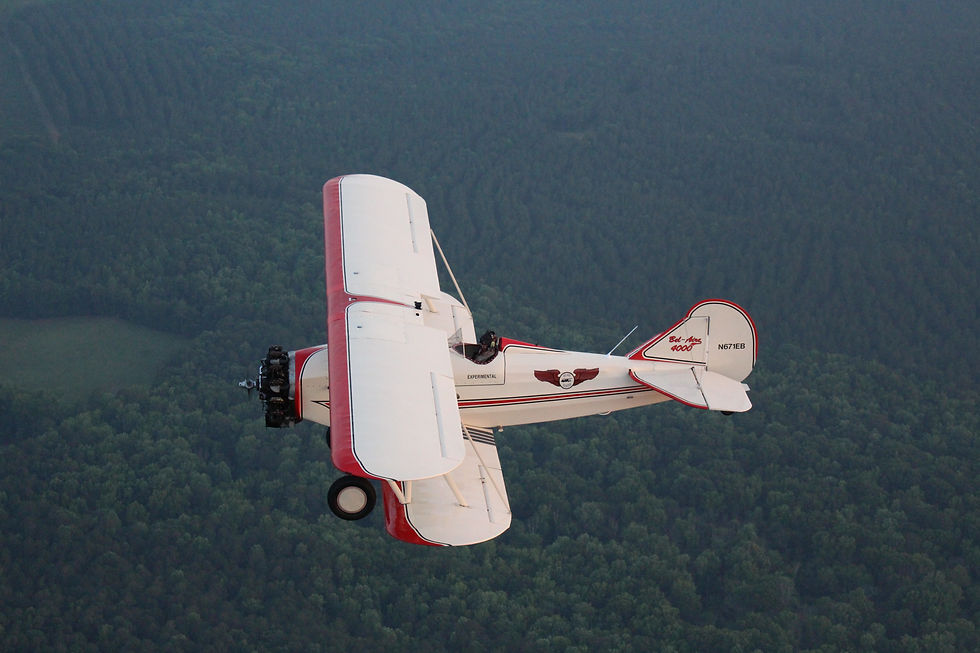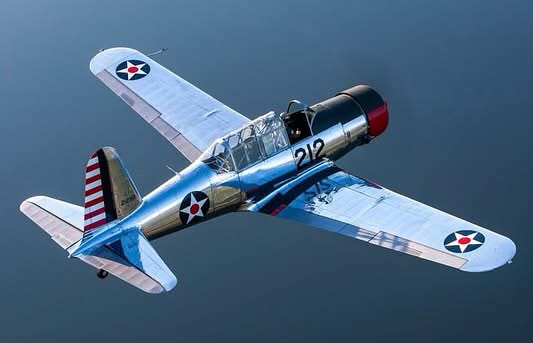Bel-Aire 4000
- J.K. Caldwell
- Jul 4, 2023
- 6 min read
A beautiful Frankenstein

First Impressions: The Bel-Aire 4000 is not a restoration or a kit-built plane, but a one-of-a-kind creation. Modeled after a Travel Air 4000, the Bel-Aire 4000 is the creation of Bill Bardin (EAA#562007), along with Gerry Belchern and Nick Fratangelo and has some truly innovative design features. This graceful and well-engineered biplane is a delight to fly over the countryside and makes all the troubles of the world below disappear.

Background: If you think the Bel-Aire 4000 bears a remarkable resemblance to the Stearman Kaydet series (PT-13/17/N2S), there’s a reason. Lloyd Stearman was the designer of the Travel Air Model A. The Travel Air 2000/3000/4000 were all developed from Stearman’s initial design, and it’s clear that the iconic WWII trainer was a direct descendant of his Travel Air Model A. In fact, the Travel Air Manufacturing Company was founded by the “Dream Team” of early aircraft visionaries. In 1925, Clyde Cessna, Walter Beech, and Lloyd Stearman founded the company in Wichita, Kansas. Three years later, Wichita became known as the Air Capital City of the U.S., with Travel Air producing more aircraft than any other aircraft manufacturer in North America. The Travel Air 4000B was an immensely successful aircraft for passengers (room for two in the front cockpit), pilot training, air mail, and as a sport plane. Charles Lindbergh actually flew a Travel Air 4000 on airmail routes between Chicago and St Louis. In 1929, seven of the 20 contestants in the first Women’s Air Derby race from Santa Monica, CA to Cleveland, OH flew Travel Airs, including the winner, Louise Thaden.

The Bel-Aire 4000 is fabricated with parts from four different aircraft, a car, two women’s handbags and contains no wood! The 4000 is the second aircraft built by Bill Bardin; his first was modeled after a 1925 Travel Air 2000. The Travel Air 2000 originally came with a 90-horsepower water-cooled Curtiss OX-5 V-8 engine. Bardin’s Bel-Aire 2000 was powered by a Chevrolet 383 V8 engine with a hand-carved wood prop. The wooden wings were exactly duplicated from Travel Air 2000 wings. Bill’s entire career has been one working with metal, first as a master welder, and later as a mechanical construction engineer. It was only natural that he wanted his second Bel-Aire to be all metal.
Design Characteristics: With only basic Travel Air drawings as a template, Bill began a project that essentially made him both an aircraft engineer and a test pilot. It seems unfair to compare this beautiful airplane to the hideous Frankenstein from Mary Shelly’s classic, but parallels do exist! The upper wings are from a Piper PA-12 Super Cruiser and the shorter, lower wings are from a PA-22-108 Colt. The wings are arranged with a positive stagger; the top wing located forward of the lower one. Aluminum N-strut bracing transfer thrust loads and adds rigidity, while stainless steel wires with javelin struts, prevent torsion and vibration. The bottom wing ailerons drive the upper ailerons with a bell crank and slave linkage rod. While the airfoils are different from the original, the wing square footage is the same as a Travel Air 2000. Using homebuilder innovation, Bill built a hinged door into the unused right lower wing fuel tank to use as a small baggage compartment. There is an additional storage compartment in the fuselage just forward of the front seat. The angular windscreens are from a Stearman and give it slightly more wind protection than the original curved Travel Air windscreens. The fuselage is constructed of fabric-covered (ceconite) 4130 chrom-moly steel, far stronger than the original chromium-molybdenum alloy steel. The tail feathers are all welded aluminum tubing and elevator trim is accomplished with cables connecting the trim wheel to a jackscrew in the tail.

The main landing gear uses a scissor-type linkage with eight external bungee cords per leg. Hanging just below the bungee cords on the landing gear, is a 10-amp Champion wind-driven generator. I knew the wheels looked different and was surprised to learn they are lightweight spun aluminum wheels from a Ford Mustang GT spare tire! Ground steering is accomplished with a Maule tailwheel assembly and Grove brakes.
Powerplant: A 1929 Travel Air 4000E came with a 165 horsepower Wright J-6-5 Whirlwind 5-cylinder radial. For the Bel-Aire 4000, Bill chose the tried and true seven-cylinder Continental W670-6A as his powerplant. The W670 delivers 220 horsepower at 2,075 rpm to a 102-inch McCauley fixed pitch propeller. Three 18-gallon fuel tanks are all in the top wing and provide 54 gallons of gravity-fed fuel to the Bendix-Stromberg carburetor. The exhaust manifold is from a Stearman PT-17, and the dish pan shielding is from a Vultee BT-13. There is a clever step welded at the top of the exhaust manifold, which helps during refueling of the tanks on the top wing. And no, it doesn’t conduct much heat, so there is no danger of melting your sneakers during a “turn and burn” fuel stop!
Preflight/Startup: Access the cockpits via the left wing, but take caution not to trip over one of the bracing wires on the non-skid walkway. You can grab the upper wing handholds and lower yourself into the extra-wide front cockpit. The forward cockpit has basic flight instruments, stick and rudder but no brakes. The pilot sits in the slightly narrower rear cockpit, and an indented step in the fuselage makes stepping in easy. The aft cockpit contains all instrumentation required for VFR flying and navigation. The pilot sits in a “bomber-style” seat with attractive deep leather pockets on either side. Bill made and modified these pockets from matching women’s handbags and are handy for just about anything the pilot may need in flight!

Takeoff: Takeoff happens sooner than one might expect, especially if anticipating Stearman-like ` performance as I was. Four Piper Cub-series wings on the same aircraft mean a lot of lift is being generated! By the time there is enough speed to raise the tail, the high-camber wings are ready to climb, whether you apply backstick pressure or not. Takeoff will occur in 600 feet or less. Climb-out at about 65 mph will yield a 600-700 fpm climb rate.
Flight Characteristics: The Bel-Air is a stable plane. The build team kept the dihedral angles for both the PA-12 wing and the PA-22 Colt wing. With these significant dihedrals, even with four ailerons, you won’t be doing any snappy aileron rolls. The rectangular elevators are large and translate to a large amount of pitch authority. The Piper US35B airfoil is known for soft stall and low speed characteristics. Combine that with two incidences on two wings, and you always have a flying wing with a mild demeanor. Surprise, surprise – the slow speed and stall characteristics are remarkably similar to the Piper Cub series! The control characteristics are indeed perfect for an afternoon sightseeing tour. Cruise speed tops out at about 90 mph with 1850 rpm and will burn about 13.5 gph and .5 quart of oil per hour. If you’re trying to deliver the mail somewhere in the dead of night, you can fly for over 3.5 hours!

Landing: Make your approach at 70 mph. Since there are no flaps to configure, selecting carburetor heat is all that is required. You can choose from a turning approach starting abeam the numbers or execute a steep approach with sideslip; both allow the pilot to maintain sight of the runway. While bungee shocks can absorb a lot of sink on touchdown, it also turns that downward kinetic energy straight back into upward kinetic energy! I learned that if you make a three-point landing, ensure it truly is a full-stall landing and not a quasi-wheel landing. Being in the no-man’s land between a three-point and wheel landing is not recommended for any taildragger, but especially the Bel-Air due to its bungee gear and relatively small rudder. Any sink will launch you skyward or at least make you light on the wheels. Without the tailwheel firmly planted on the deck, tailwheel steering is non-existent. With this lesson learned, my next full-stall, three-point landing was much less exciting!

Wrap-Up: The Bel-Aire 4000 pays admirable homage to the successful and iconic Travel Air 4000 while making significant modern upgrades. This gorgeous machine should be an inspiration to homebuilders everywhere. It demonstrates that ideas, innovation and old-fashioned hard work can turn concepts into reality – and a beautiful one at that!


.png)




What a great review on a very interesting plane!